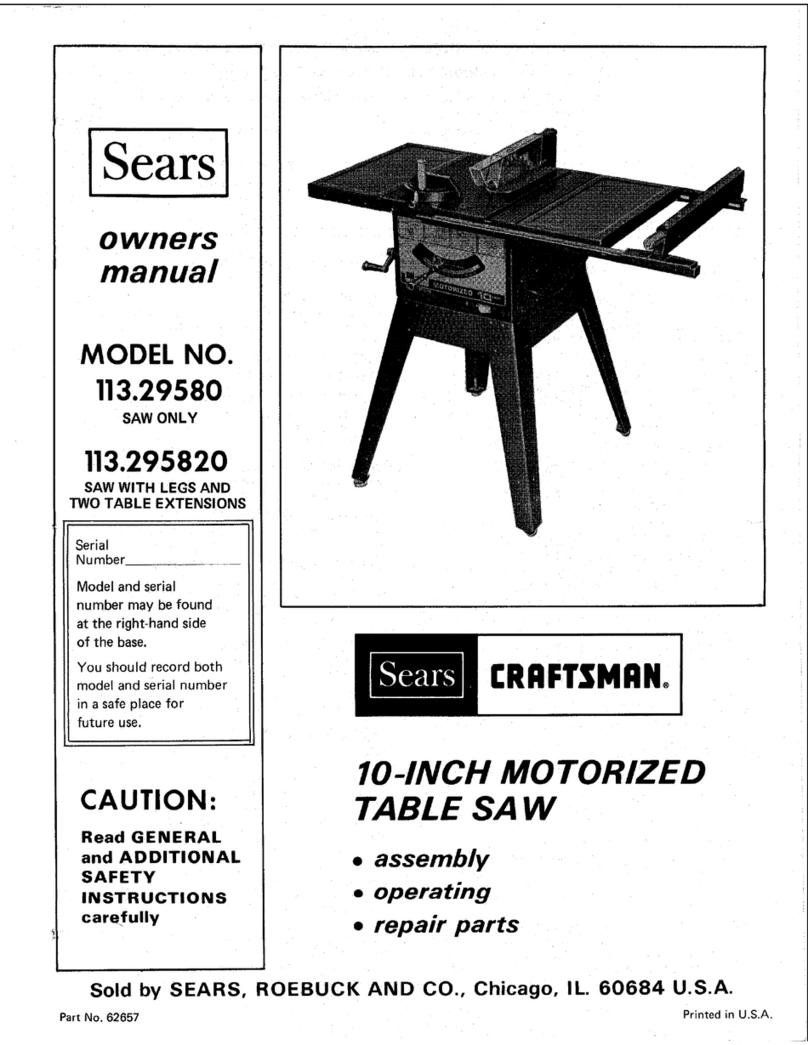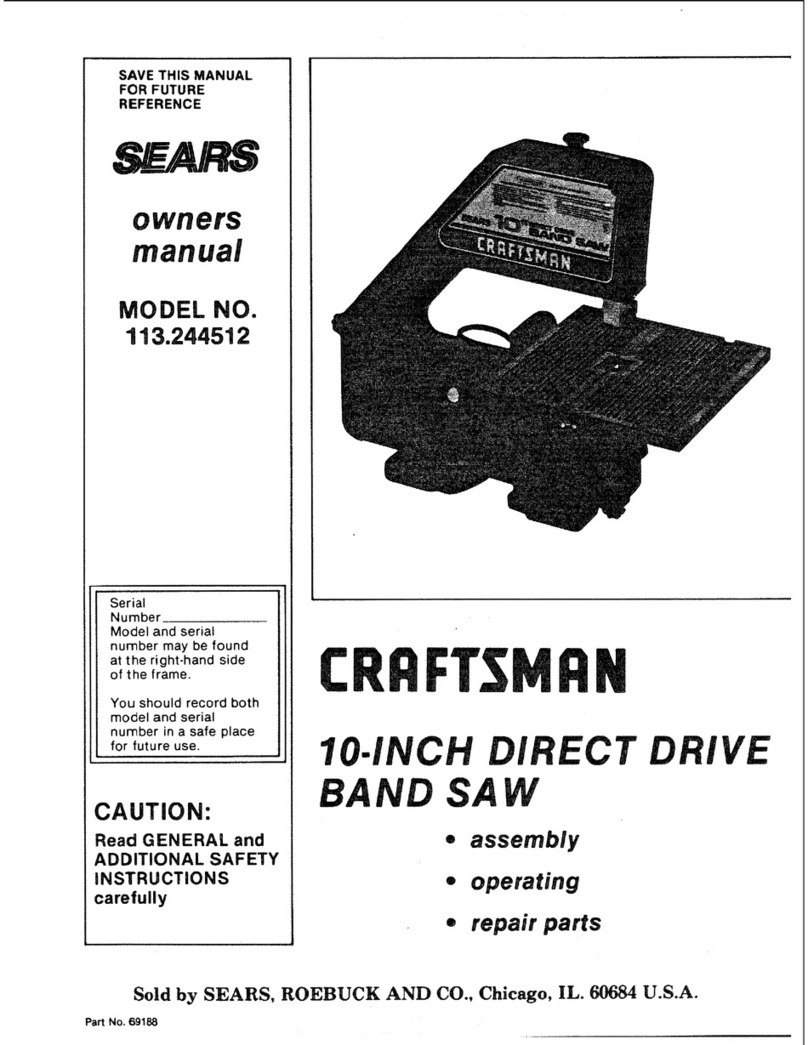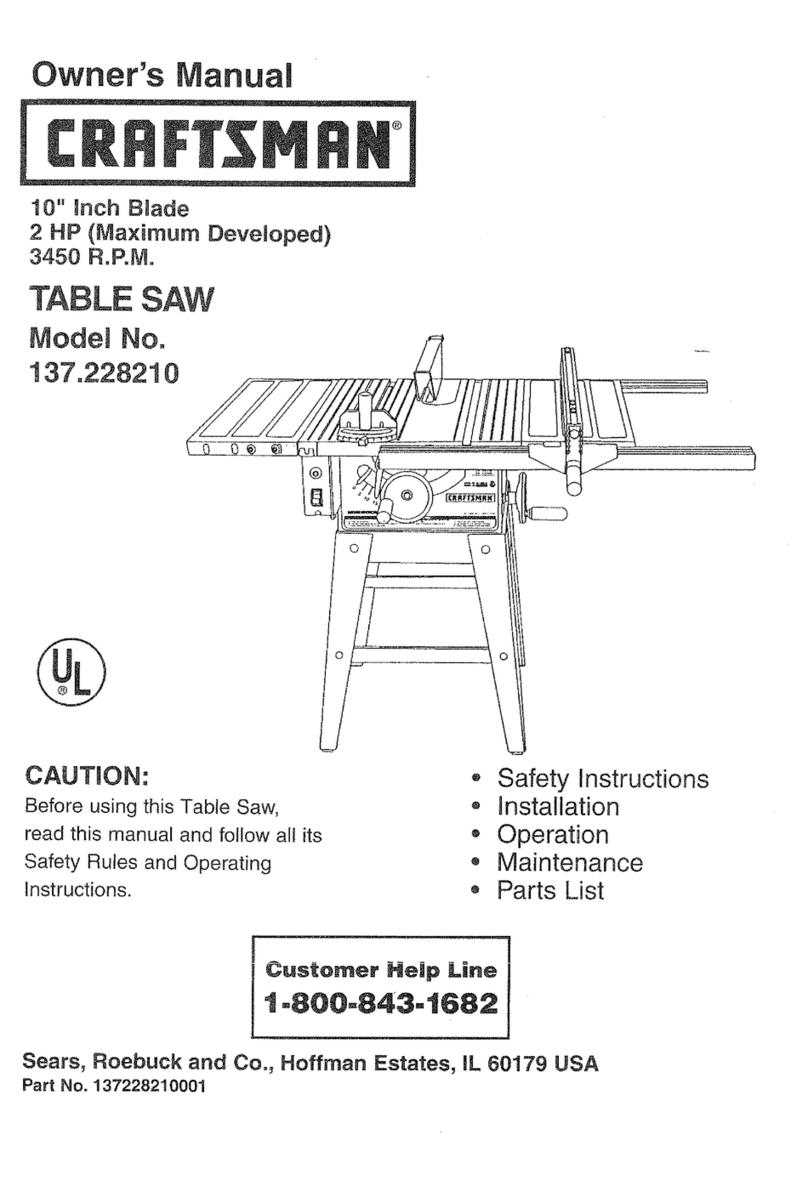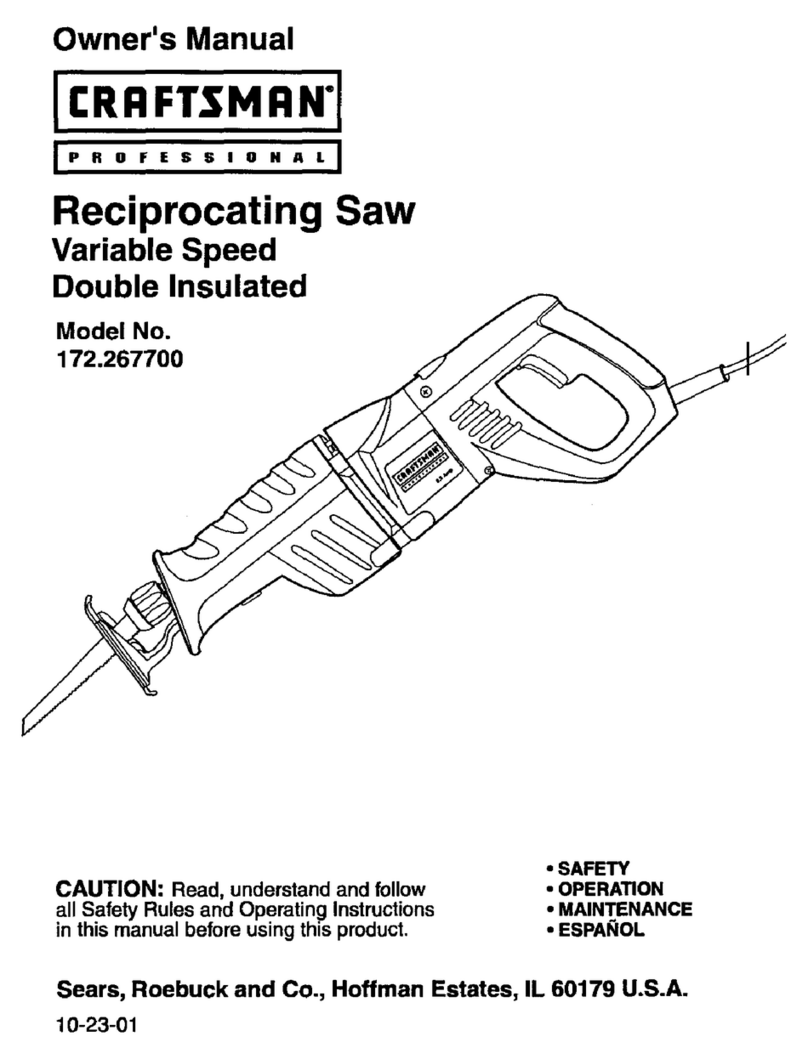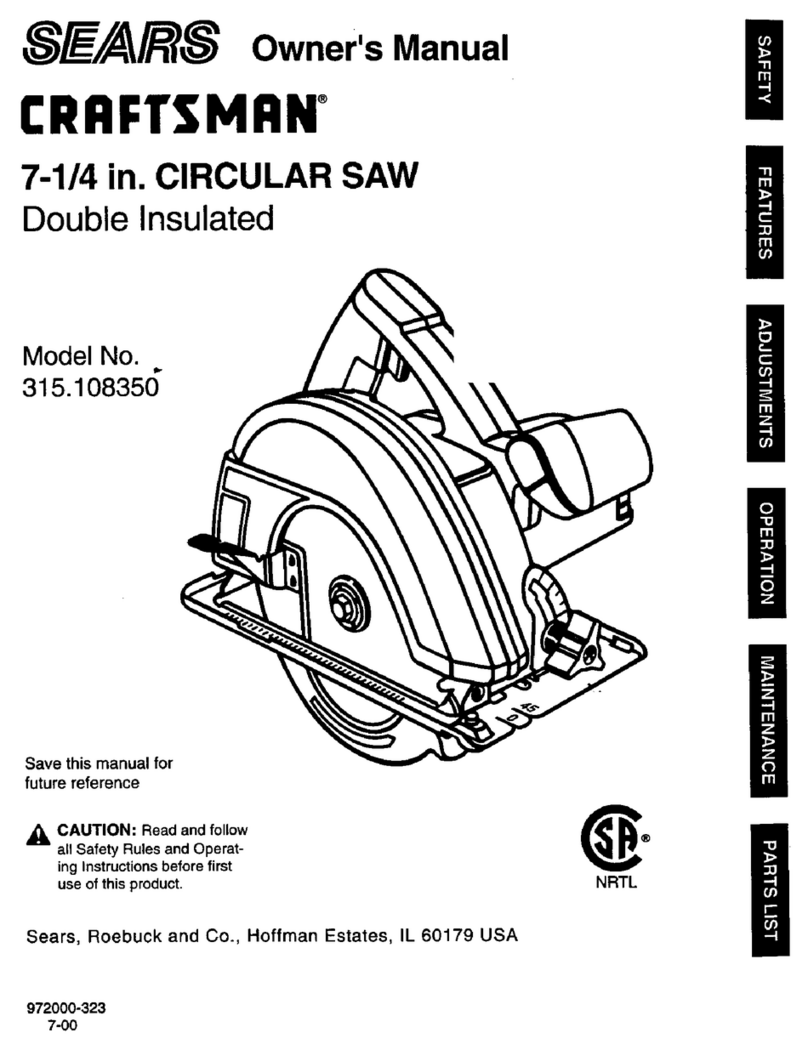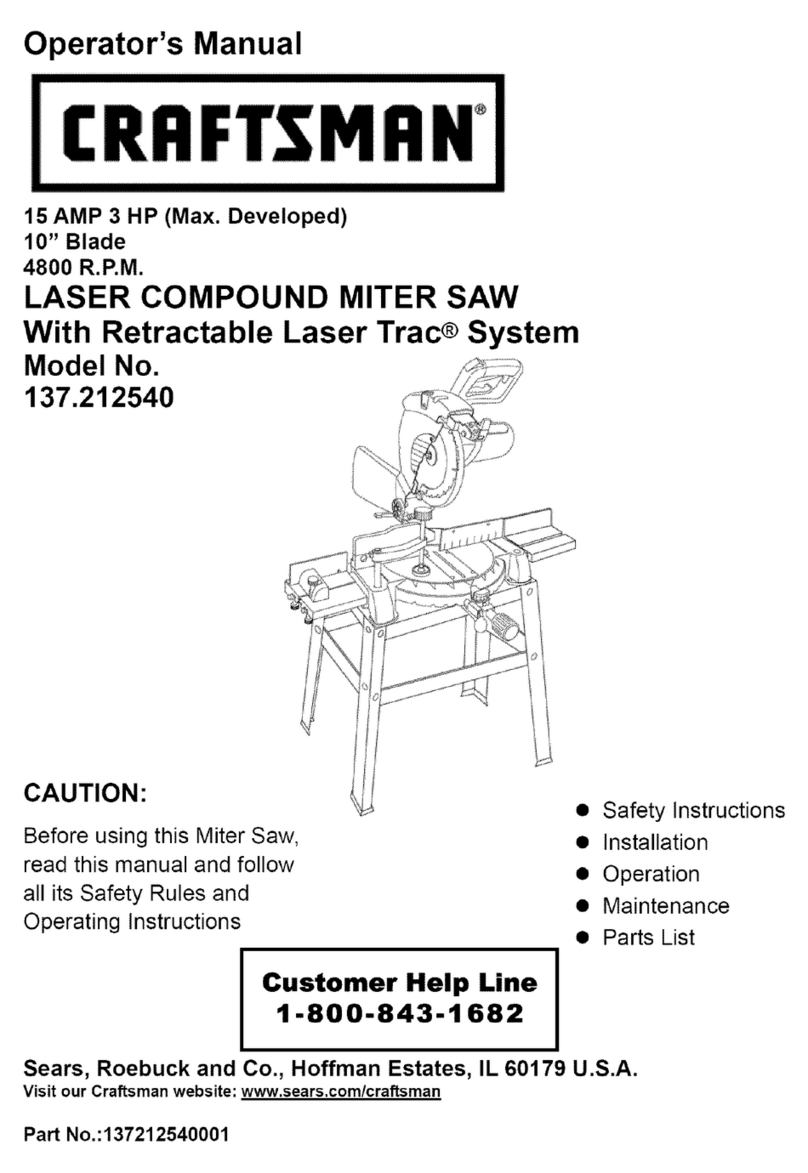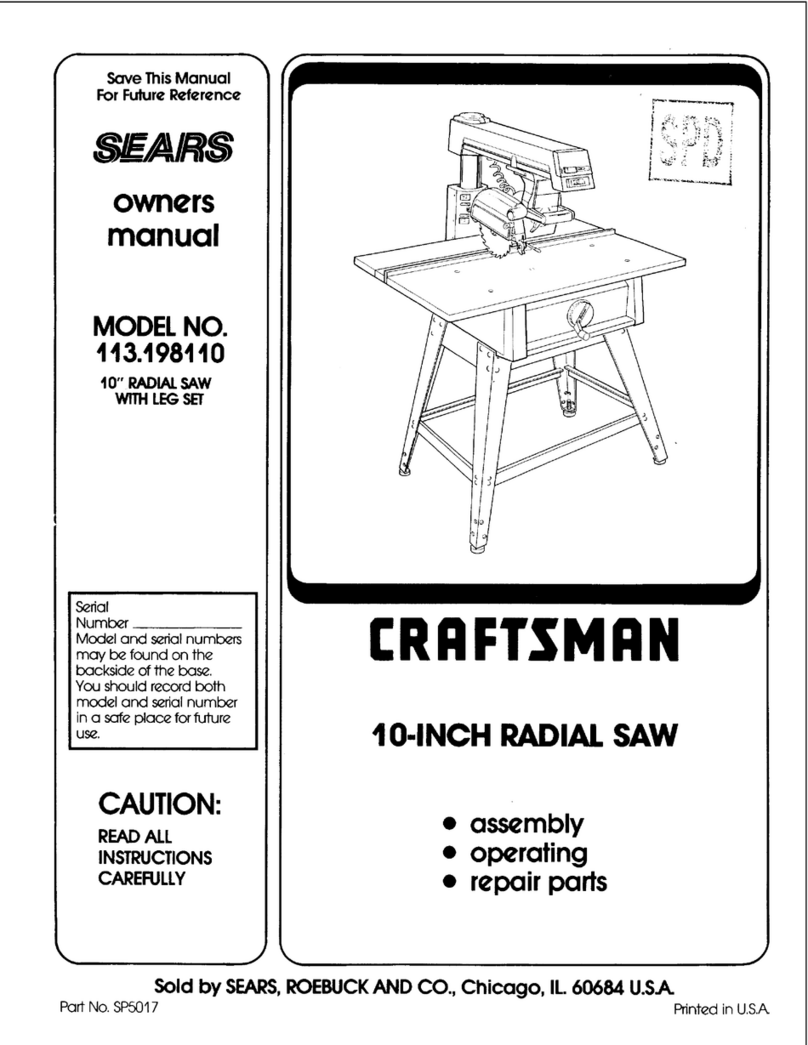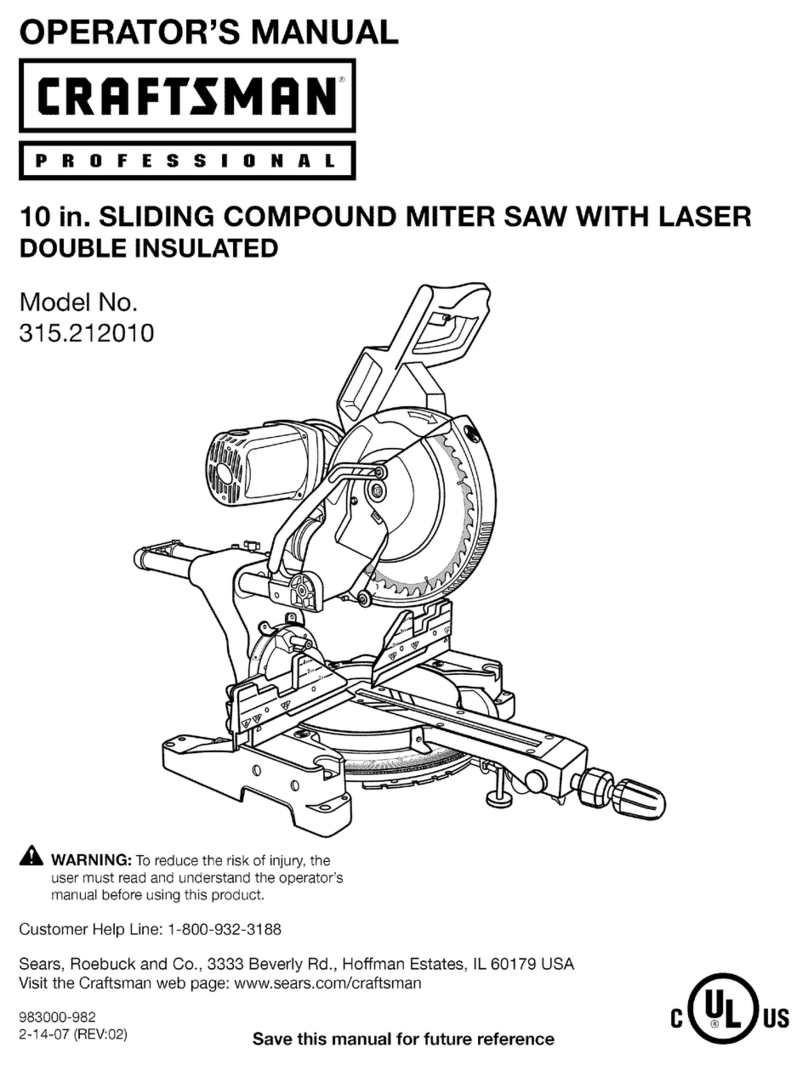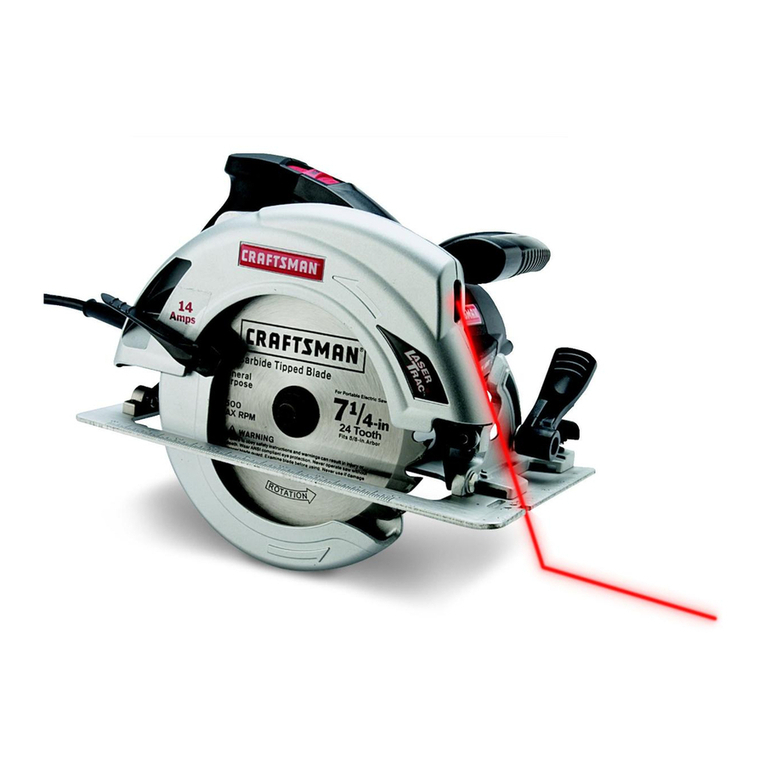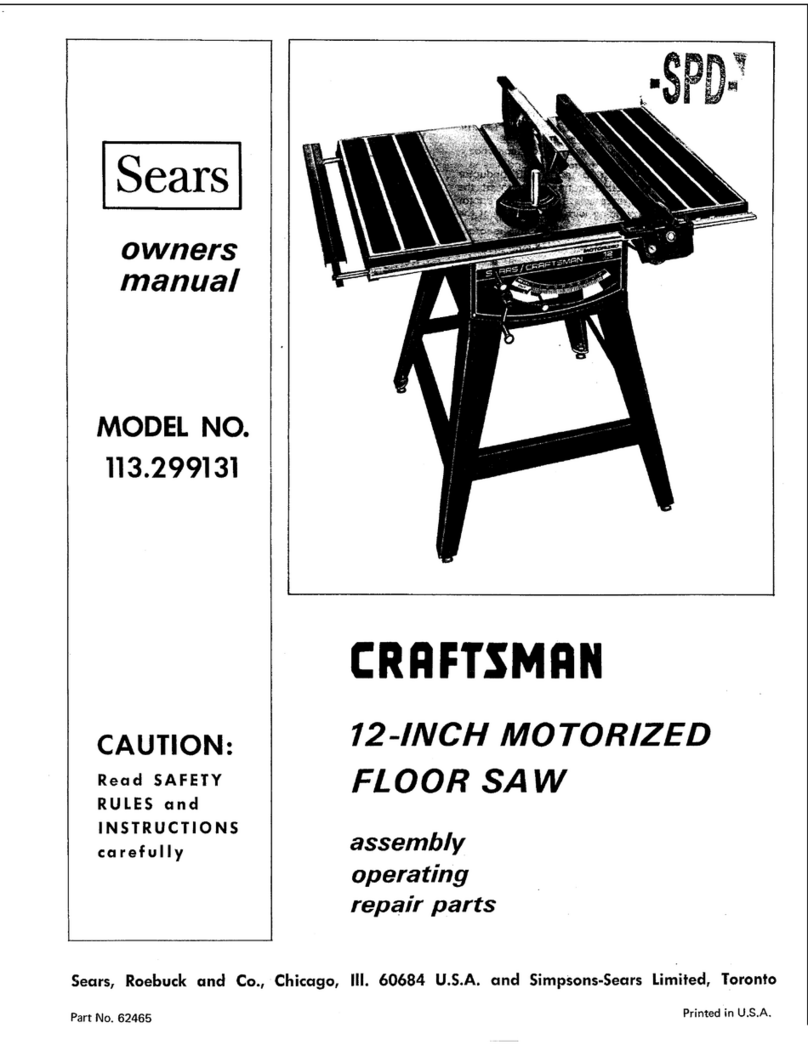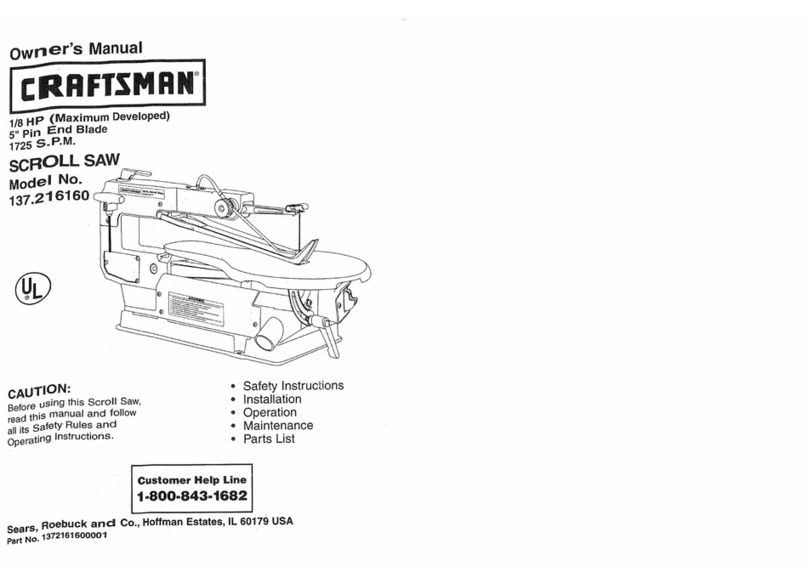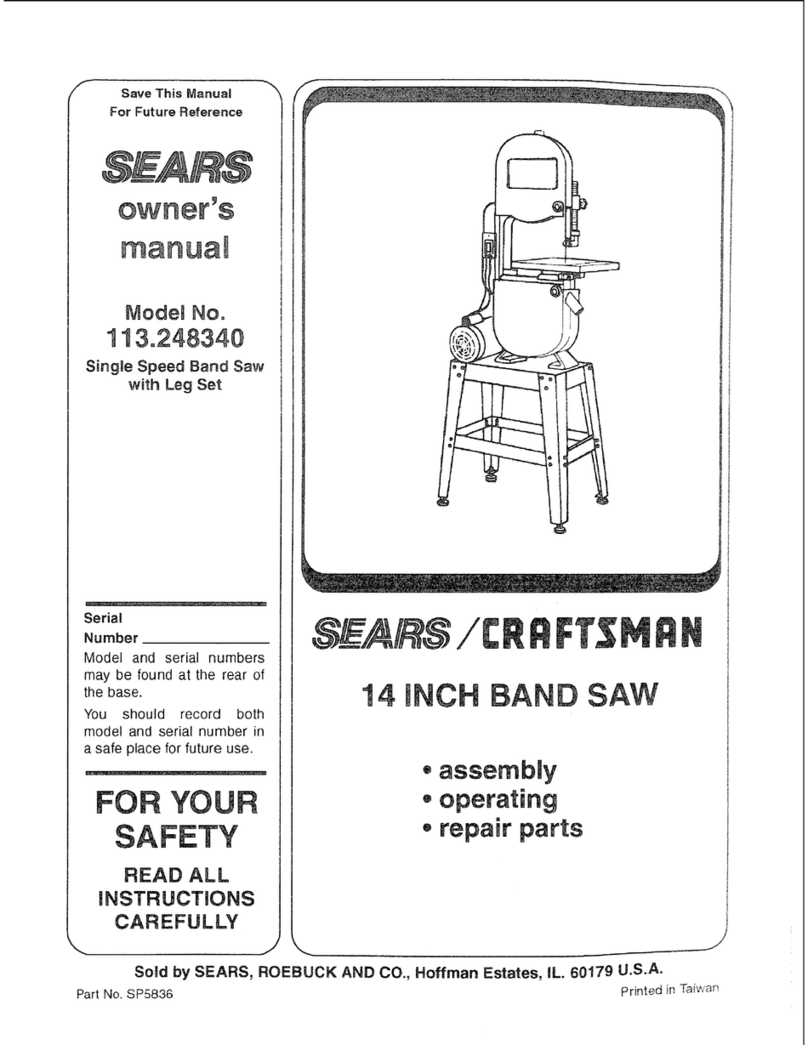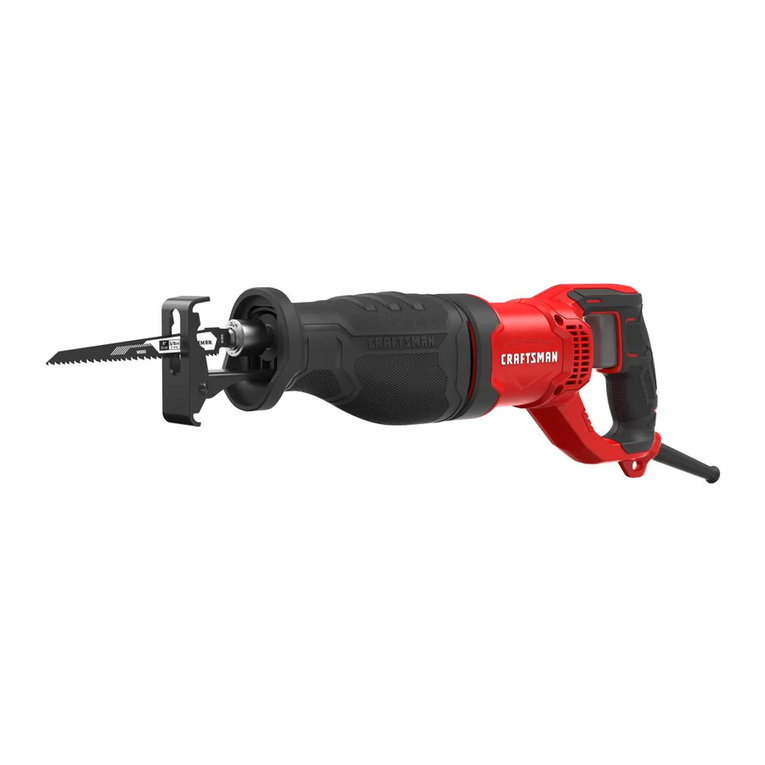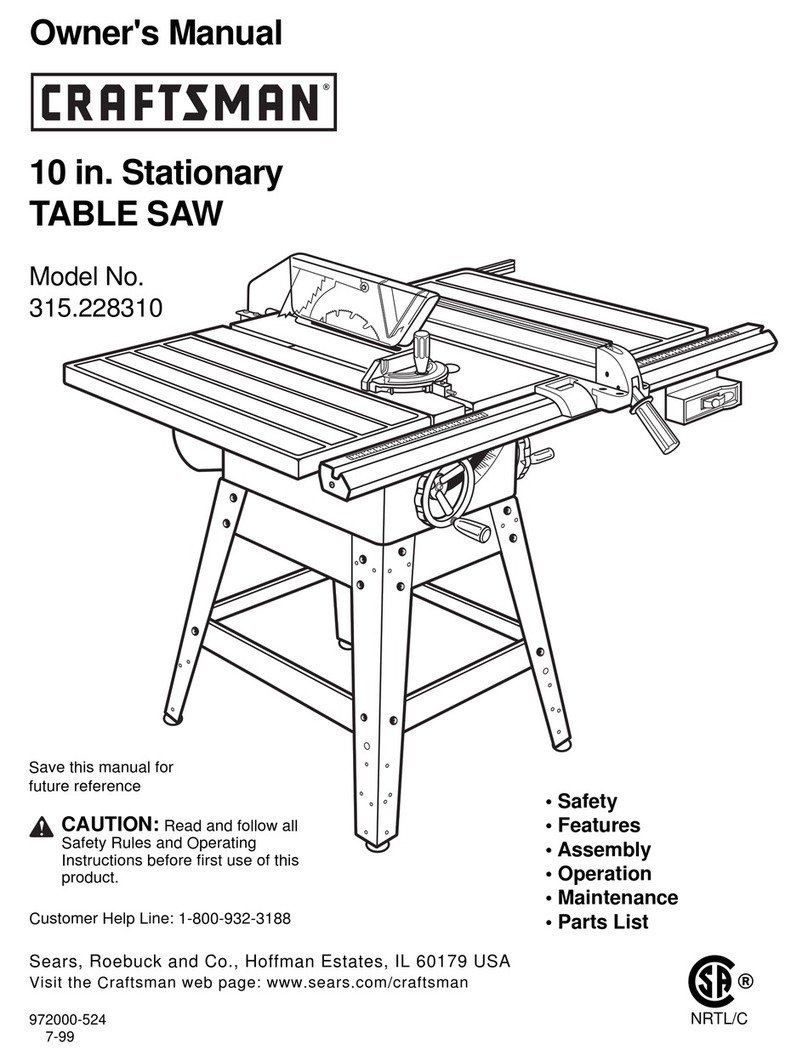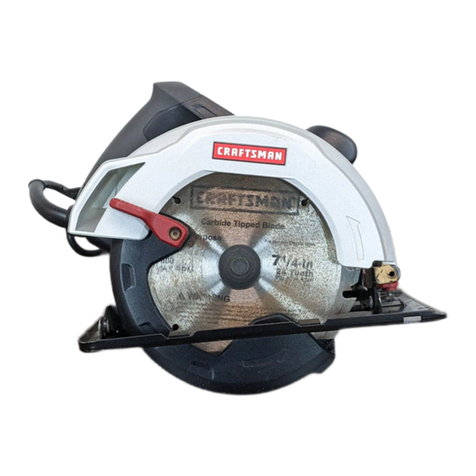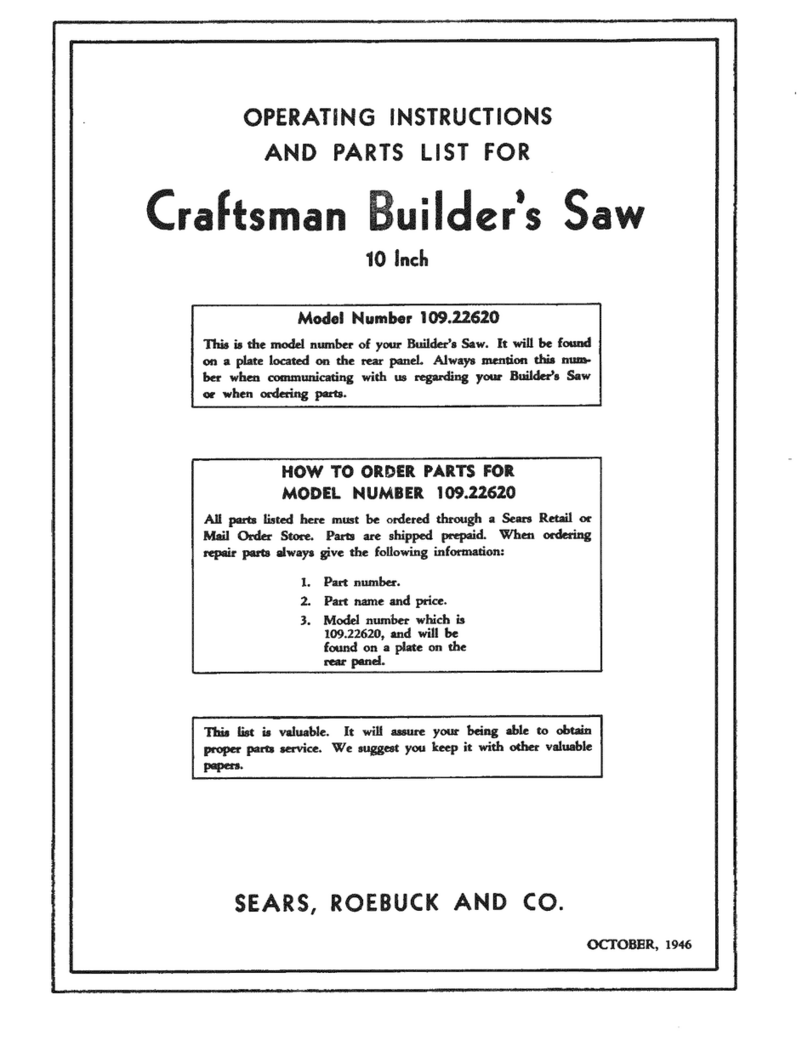_0. NEVER LEAVETOOL RUNNING UNATTENDED.
TURN THE POWER OFF. Don't leave the tool until it
comes to a complete stop.
!1. DON'T OVERREACH. Keep proper footing and balance
at all times.
!2. MAINTAIN TOOLS WITH CARE. Keep tools sharp and
clean for best and safest performance. Follow
instructions for lubricating and changing accessories.
!3. DO NOT use power tools in the presence of flammable
liquids or gases.
'.4. DO NOT operate the tool if you are under the influence
of any drugs, alcohol or medication that could affect
your ability to use the tool properly.
;5. ALWAYS operate the band saw in a wellwentilated area
and provide for proper dust removal. Use dust collection
systems whenever possible. Dust generated from
certain materials can be hazardous to your health.
;PECIFgC SAFETY INSTRUCTBONS
TO AVOID INJURY from unexpected movement, make
sure the saw is on a firm, level surface, properly secured
to prevent rocking. Make sure there is adequate space
for operating. Bolt the saw to a support surface to
prevent slipping, walking, or sliding during operation.
TURN the saw OFF and unplug the saw before
moving it.
USE THE CORRECT size and style of blade.
USE blades recommended at 2600 FPM or greater.
MAKE SURE the blade teeth point down and towards
the table.
BLADE GUIDES, SUPPORT BEARINGS, AND
BLADE TENSION must be properly adjusted to avoid
accidental blade contact and to minimize blade
breakage. To maximize blade support, always adjust
the upper blade guide and blade guard so that it is
1/8 inch above the workpiece.
TABLE LOCK HANDLE should be tight.
USE EXTRA CAUTION with large, very small or
awkward workpieces.
USE EXTRA SUPPORTS to prevent workpieces from
sliding off the table top. Never use another person in
place of a table extension, or to provide additional
support for the workpiece.
0. WORKPIECES must be secured so they don't twist,
rock, or slip while being cut.
SAVE THESE
11.
12.
I3.
14.
15.
16.
PLAN intricate and small work carefully to avoid
pinching the blade. Avoid awkward operation and hand
positions to prevent accidental contact with the blade.
SMALL PIECES should be secured with jigs or
fixtures. Do not hand hold pieces that are so small your
fingers are under the blade guard.
SUPPORT round work properly (with a V-block or
clamped to the miter gauge) to prevent it from rolling
and the blade from biting.
CUT only one workpiece at a time. Make sure the table
is clear of everything except the workpiece and its
guides before you turn the saw on.
MAKE RELIEF CUTS when cutting long curves.
ALWAYS WATCH the saw run before each use. If there
is excessive vibration or unusual noise, stop immediately.
Turn the saw off. Unplug it immediately. Do not start
the saw again until the problem has been located and
corrected.
17.
18.
TO FREE any jammed material, turn the switch OFR
Remove the switch key and unplug the saw. Wait for all
moving parts to stop before removing jammed material.
DON'T LEAVE the work area until all moving parts are
stopped. To childproof the workshop, shut off the power
to master switches and remove the switch key from the
band saw. Store it in a safe place, away from children.
For your own safety, read the entire instruction manual
before operating the band saw.
t. Wear eye protection.
2. Do not wear gloves, necktie, or loose clothing.
3. Make sure the saw is on a firm level surface and
properly secured.
4. USEONLYTHE RECOMMENDED ACCESSORIES.
5. Use extra caution with very large, very small, or
awkward workpieces.
6. Keep hands away from the blade at all times to
prevent accidental injury.
Do not remove jammed cutoff pieces until blade has
stopped.
Maintain proper adjustment of blade tension, blade
guides, and thrust bearings.
Adjust upper guide to just clear workpiece.
Hold workpiece firmly against table.
,
8.
9.
10.
ELECTRICAL REQUHREMENTS
POWER SUPPLY AND MOTOR SPEC_FICATIONS
To avoid electrical hazards, fire hazards, or damage to the
NSTRUCTRONS
4
tool, use proper circuit protection. Use a separate electrical
circuit for your tools.Your saw is wired at the factory for
120V operation. Connect to a 120V, 15 Amp circuit and
use a I5 Amp time delay fuse or circuit breaker. To avoid
shock or fire, if power cord is worn or cut, or damaged-in
any way, have it replaced immediately.
INSTALLED BY A QUALIFIED ELECTRICIAN. The
Canadian Electrical Code prohibits the use of adapters.
CAUTION: In all cases, make certain the receptacle is
properly grounded, tf you are not sure have a qualified
electrician check the receptacle.
GROUNDING INSTRUCTIONS
This tool must be grounded while in use to protect the
operator from electrical shock.
IN THE EVENT OF A MALFUNCTION OR BREAKDOWN,
grounding provides a path of least resistance for electric
current and reduces the risk of electric shock. This tool is
equipped with an electric cord that has an equipment
grounding conductor and a grounding plug. The plug
MUST be plugged into a matching receptacle that is
properly installed and grounded in accordance with ALL
local codes and ordinances.
DO NOT MODIFY THE PLUG PROVIDED. If it will not fit
the receptacle, have the proper receptacle installed by a
qualified electrician.
IMPROPER CONNECTION of the equipment grounding
conductor can result in risk of electric shock. The
conductor with the green insulation (with or without yellow
stripes) is the equipment grounding conductor. If repair
or replacement of the electric cord or plug is necessary,
DO NO[ connect the equipment grounding conductor
to a five'terminal.
CHECK with a qualified electrician or service person if you
do not completely understand the grounding instructions, or
if you are not sure the tool is properly grounded,
USE ONLY 3-wire extension cords that have 3-prong
grounding plugs and 3-pole receptacles that accept
the tool's plug. Repair or replace damaged or worn
cord immediately.
Use a separate electrical circuit for your tools. This circuit
must not be less than #12 wire and should be protected
with a 15 Amp time lag fuse. Before connecting the motor
to the power line, make sure the switch is in the OFF
position and the electric current is rated the same as the
current stamped on the motor nameplate, Running at a
Lowervoltage will damage the motor.
This tool is intended for use on a circuit that has a receptacle
like the one illustrated in FIGURE A. FIGURE A shows a
3-prong electrical plug and receptacle that has a grounding
conductor. If a properly grounded receptacle is not available,
an adapter (FIGURE B) can be used to temporarily connect
this plug to a 2-contact ungrounded receptacle.
The temporary adapter should be installed by a qualified
technician. The adapter (FIGURE B) has a rigid lug
extending from it that MUST be connected to a permanent
earth ground, such as a properly grounded receptacle box.
THE TEMPORARY ADAPTER SHOULD BE USED ONLY
UNTIL A PROPERLY GROUNDED OUTLET CAN BE
Fig. A3-Prong Plug
Properly Grounded
3-Prong Receplacte
Fig. B Grounding Lug
Make Sure This
is Connected to a
Known Ground
-Prong
eceptacle
This band saw is for indoor use only, Do not expose to rain
or use in damp locations
GUIDEUNES FOR EXTENSION CORDS
USE PROPER EXTENSION CORD. Make sure your
extension cord is in good condition. When using an
extension cord, be sure to use one heavy enough to carry
the current your product will draw. An undersized cord will
result in a drop in line voltage and in loss of power which will
cause the tool to overheat. The table below shows the
correct size to use depending on cord length and nameplate
ampere rating. If in doubt, use the next heavier gauge. The
smaf]er the gauge number, the heavier the cord.
Be sure your extension cord is properly wired and in
good condition. Always replace a damaged extension cord
or have it repaired by a qualified person before using it.
Protect your extension cords from sharp objects, excessiv
heat and damp or,wet areas.
(when using 120 volts only) In feet
more than notmorethan 25' 50' 100' 150'
........... , ............................ i
0 6 18 16 16 t4
6 10 t8 16 14 12
10 t2 16 16 14 t2
12 16 14 !12 Not recomrnended
SAVE THESE INSTRUCTIONS
